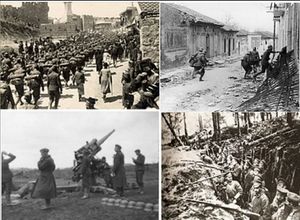Difference between revisions of "Siyezi civil war"
| Line 23: | Line 23: | ||
| combatant2 = "Loyalists"<br><b>Supported by:</b><br>{{flag|Komania}}<br>{{flag|Balak Empire}} | | combatant2 = "Loyalists"<br><b>Supported by:</b><br>{{flag|Komania}}<br>{{flag|Balak Empire}} | ||
| combatant3 = | | combatant3 = | ||
| commander1 = { | | commander1 = {{flagicon|Siyezan}} Boğdan Arğuzil | ||
| commander2 = | | commander2 = {{flagicon|Siyezan}} Arzin III<br>{{flagicon|Siyezan}} Aşir Virnaba | ||
| commander3 = | | commander3 = | ||
| units1 = | | units1 = | ||
| Line 47: | Line 47: | ||
With his death in 1940, his son Arzin III took power. As soon as he arrived, he started his struggle to liberalising the country, disbanding the secret police, and stopping the suppression of other ideologies, as he stated that the need for protecting the country via an autocracy was over. | With his death in 1940, his son Arzin III took power. As soon as he arrived, he started his struggle to liberalising the country, disbanding the secret police, and stopping the suppression of other ideologies, as he stated that the need for protecting the country via an autocracy was over. | ||
= Arghuzil's coup and start of the conflict = | = Arghuzil's coup and start of the conflict = | ||
Many conservatives were unfriendly to Arzin III's policies, as they believed they would open Siyezan to strife and conflict, which would inevitably lead to foreign domination, likely by Terminia if Kuulism were to take hold in the nation, an idea which many of them disliked heavely. In early 1942, various army commanders started meeting in secret | Many conservatives were unfriendly to Arzin III's policies, as they believed they would open Siyezan to strife and conflict, which would inevitably lead to foreign domination, likely by Terminia if Kuulism were to take hold in the nation, an idea which many of them disliked heavely. In early 1942, various army commanders started meeting in secret, forming the | ||
= Course of the war = | = Course of the war = | ||
= Aftermath = | = Aftermath = | ||
Revision as of 15:44, 19 February 2021
| Siyezi civil war | |||||||
|---|---|---|---|---|---|---|---|
 Clockwise from top left: Loyalist troops in the Svaljem offensive, Sannist soldiers looting occupied Tízson, Loyalist trench in the forests near Dúnacan, Sannist detachment operating an AA. | |||||||
| |||||||
| Belligerents | |||||||
|
"Sannists" Supported by: |
"Loyalists" Supported by: | ||||||
| Commanders and leaders | |||||||
|
|
| ||||||
| Casualties and losses | |||||||
|
Military dead: TBA Civilian dead: TBA Total dead: TBA |
Military dead: TBA Civilian dead: TBA Total dead: TBA | ||||||
The Siyezi civil war (Damserz: Síyeba írba hód [siː.je.ˈbɒ ˈiːr.bɒ ħɵːd] "Siyezi home war") was a civil war fought in Siyezan by 2 factions:
- - The "Sannists", formed by a coalition of Sannists, Nationalists, and more extreme conservatives, led by general Miştan Arğuzil.
- - The "Loyalists", formed by everyone who was loyal to the old government and king Arzin IV (hence the name), with a great variety of groups from different ideologies forming this faction.
Prelude
Following the Second War of Independence from Vosan, the country was left in ruins and there was a great uncertainty for the future, making the country a perfect battleground for extremist ideologies. To ensure stability, king Camay VI, coronated in 1921, ruled as an autocrat. He ruled with an iron fist, installing a secret police and suppressing his opposition as well as various extremist ideologies, mainly Balko-Kuulism and it's variations. His autocracy quickly became known across Vaniua and presented as an example of a stuck-in-the-past country. While a parliament existed, it was limited in its power and it's members could only be appointed by Camay VI.
With his death in 1940, his son Arzin III took power. As soon as he arrived, he started his struggle to liberalising the country, disbanding the secret police, and stopping the suppression of other ideologies, as he stated that the need for protecting the country via an autocracy was over.
Arghuzil's coup and start of the conflict
Many conservatives were unfriendly to Arzin III's policies, as they believed they would open Siyezan to strife and conflict, which would inevitably lead to foreign domination, likely by Terminia if Kuulism were to take hold in the nation, an idea which many of them disliked heavely. In early 1942, various army commanders started meeting in secret, forming the